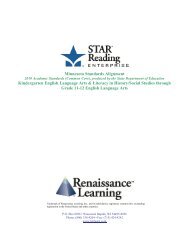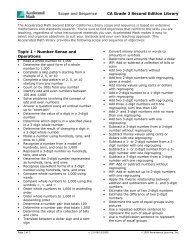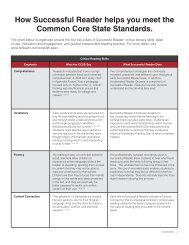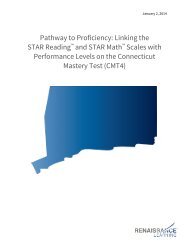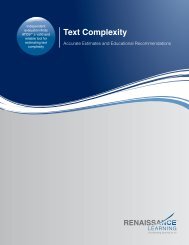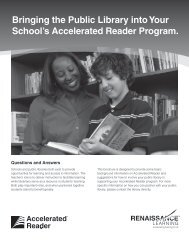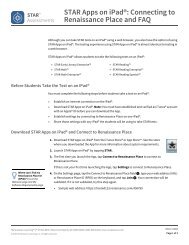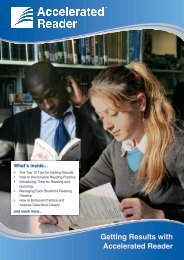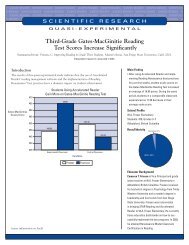Technical Manual - Renaissance Learning
Technical Manual - Renaissance Learning
Technical Manual - Renaissance Learning
You also want an ePaper? Increase the reach of your titles
YUMPU automatically turns print PDFs into web optimized ePapers that Google loves.
NormingSTAR Early Literacy Enterprise 2014 NormingNationally representative test score norms were computed for the first time forSTAR Early Literacy Enterprise assessments, for introduction at the beginning ofthe 2014–15 school year. This chapter describes the 2014 norming of STAR EarlyLiteracy Enterprise.In addition to Scaled Score norms, which are distributions of the scoresthemselves, <strong>Renaissance</strong> <strong>Learning</strong> has developed growth norms for STAR EarlyLiteracy Enterprise. This chapter includes two sections. The first one deals with the2014 development of the STAR Early Literacy Enterprise test score norms. Asecond section describes the development and use of the growth norms. Growthnorms are very different from test score norms, having different meaning anddifferent uses. Users interested in growth norms should familiarize themselveswith the differences, which are made clear in the growth norms section.Development of Norms for STAR Early Literacy Test ScoresSample CharacteristicsStudents’ STAR Early Literacy Enterprise data that was available in the<strong>Renaissance</strong> Place hosted learning environment from fall 2012 to spring 2013 wereused for the 2014 STAR Early Literacy Enterprise norming study. The normingsample included students from all US states and the District of Columbia.Information about school and district demographic data were obtained fromMarket Data Retrieval (MDR), National Center for Education Statistics (NCES), andthe US Bureau of Census. Students’ demographic data, when recorded by theschools, also included gender, race/ethnicity, Students with Disabilities (SWD),and English Language Learners (ELL).To obtain a representative sample of the US school population for appropriate falland spring norming, the first step identified a matched sample of 332,392 studentswith both fall and spring STAR Early Literacy Enterprise assessment scores. Thematched sample of students had completed a STAR Early Literacy assessment inthe first three months of the 2012–2013 school year (fall) and also a STAR EarlyLiteracy assessment in the last three months of the 2012–2013 school year(spring). This step insured that the norming process would apply to the samegroup of students for the full school year irrespective of the time of administrationof the STAR Early Literacy Enterprise assessment.STAR Early Literacy<strong>Technical</strong> <strong>Manual</strong>100





